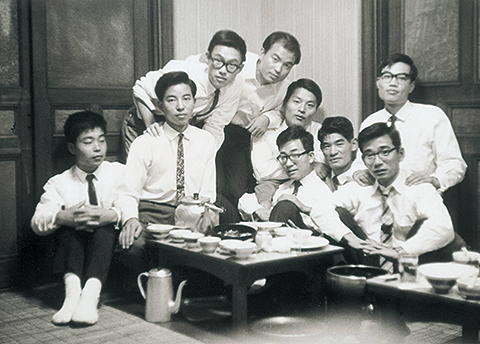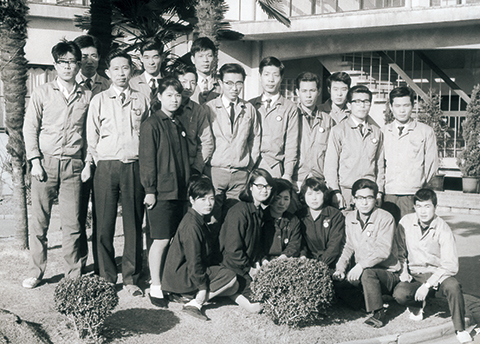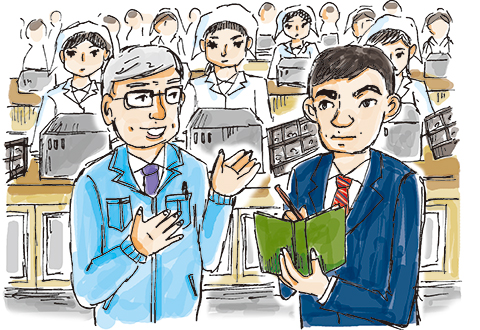Chapter 2Career Launch
3.First Employment at Mitsubishi Electric Corporation“He who falls today may rise tomorrow”
Soon after Shindo joined Mitsubishi, he was assigned to the Kyoto factory which was recently constructed and just opened. He was one of the first members there. One of his early colleagues recalls his first meeting with Shindo; “He was a man of few words and rather quiet. He didn’t seem like the kind of person to throw caution to the wind, but later we would find out differently.

At the Kyoto factory, Shindo was in charge of producing photo sensors. At that time there was little demand for the photo sensors, and his project never saw “the light of day”. While Mitsubishi was working on reorganizing its business after withdrawing from the photo sensors market, Shindo and two other employees were left behind in the empty office since they had not yet assigned to their next positions. Nobody at Mitsubishi seemed to care about them; so they searched for ways to help pass the many hours that they spent in the office.
They started out by reading academic books, but eventually these changed to novels and then weekly magazines. They just sat around wasting time. It was hard to spend their days with nothing to do, and they became very demotivated. Finally, after they had enough, they all handed in their resignation letters. Mitsubishi then seriously considered their reassignments and decided to transfer the entire photo sensor project to Minolta Co., Ltd. (currently Konica Minolta, Inc.), so Shindo and the other two employees were sent there.
Within the first two years after of starting his career, Shindo experienced a microcosm of an office worker’s experience – He was assigned to a new project, had the project cancelled, was sidetracked with no position and then transferred to another company and project. In looking back, this was an important time because Shindo developed the drive and spirit to overcome difficulties as well as learn the essence of entrepreneurship.
4.Encounter with Lifetime WorkRecognition of His Presence

When Shindo finished his project at Minolta, he was transferred back to Mitsubishi where a new IC project at the Kita-Itami Works was being launched. Once again, he was one of the first members of a new project.
During Shindo’s first year at the Kita-Itami Works, he was put in charge of various back office projects such as developing standard procedures for specifications, cost accounting, project planning, investment planning and production planning. This was not a good fit for him because he had spent two years to become a semiconductor process engineer and now he was not doing any development work. His colleagues who had been engaging in this project since joining the company looked down on Shindo, and one of them even said to him,
“You are totally useless.” This comment definitely kindled his indomitable spirit, and he became determined to overtake his colleagues as soon as he could. At this time in Japan, there were only a few articles about ICs; as this was the dawn of the IC era and not much was known or written about it. Shindo began to acquire as much knowledge as he could from his senior colleagues and engineers as well as from the workers on the assembly lines and from any other source he could find. He read a large amount of books and other literature as well as process specifications. He spent much time observing the manufacturing lines and learning the operations so that he could catch up with his colleagues.
Two years after Shindo was transferred to the Kita-Itami Works, he was a participant on the MOS integrated circuit development team and contributed to the success of project. He was involved in several important technological development projects on the leading edge of semiconductor manufacturing. At just 32, Shindo was promoted to a senior staff position in the IC production department that took responsibility for managing people, goods, services, and money.

In the early 1970s, Intel released the microprocessor, peripheral LSIs and the concept of integrated memory. Shortly after that, Texas Instruments and Motorola introduced new products, and the IC industry entered a new phase of dynamic growth. Meanwhile, Shindo kept increasing the integration density of Integrated circuits each year. However, he eventually lost his fascination with just increasing their capacity by improved processing technology, and his interest shifted toward circuit design. He decided to leave Mitsubishi and find some new opportunities.









